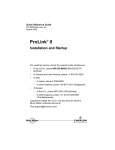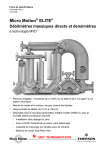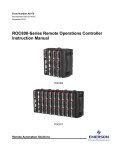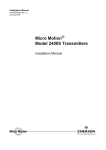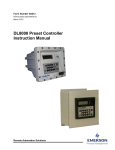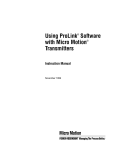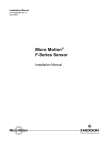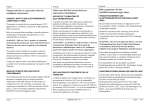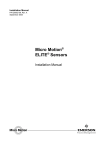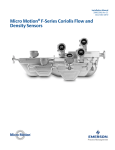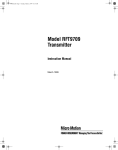Download Emerson 3350 Instruction manual
Transcript
Quick Reference Guide P/N 20001008, Rev. B August 2005 Model 3700 Transmitter (MVD) or Model 3350 Peripheral Installation Instructions for Field-Mount For technical support, phone the support center nearest you: • In the U.S.A., phone 1-800-522-MASS (1-800-522-6277) • In Canada and Latin America, phone (303) 527-5200 • In Asia, phone (65) 6770-8155 • In the U.K., phone 0800 - 966 180 (toll-free) • Outside the U.K., phone +31 (0) 318 495 670 BEFORE YOU BEGIN This quick reference guide explains basic installation guidelines for installing the Micro Motion® Model 3350/3700 MVD applications platform. For information on I.S. applications, refer to Micro Motion approval documentation. For complete instructions about configuration, maintenance, and service, refer to the instruction manual shipped with the transmitter. WARNING Improper installation in a hazardous area can cause an explosion. For information about hazardous applications, refer to Micro Motion approval documentation, shipped with the transmitter or available from the Micro Motion web site. WARNING Hazardous voltage can cause severe injury or death. Install transmitter and complete all wiring before supplying power. CAUTION Improper installation could cause measurement error or meter failure. Follow all instructions to ensure transmitter will operate correctly. ©2005, Micro Motion, Inc. All rights reserved. Micro Motion is a registered trademark of Micro Motion, Inc. The Micro Motion and Emerson logos are trademarks of Emerson Electric Co. All other trademarks are property of their respective owners. 1 European installations This Micro Motion product complies with all applicable European directives when properly installed in accordance with the instructions in this quick reference guide. Refer to the EC declaration of conformity for directives that apply to this product. The EC declaration of conformity, with all applicable European directives, and the complete ATEX Installation Drawings and Instructions are available on the web at www.micromotion.com/atex or through your local Micro Motion support center. Installation kit The Model 3350/3700 installation kit includes the parts shown in Figure 1. Figure 1. Field-mount installation kit Mounting bracket 4 x Lock washer Transmitter can be oriented on bracket. See Step 3. 4 x Flat washer 4 x M8x16 Bolt assemblies 2 STEP 1. Choosing a location Choose a location for the transmitter based on the requirements described below. WARNING Improper installation in a hazardous area could cause an explosion. Install the transmitter in an area that is compatible with the rating on the approvals tag. See Figure 3. Environmental requirements Install the Model 3350/3700 according to specified limits: • Ambient temperature: –4 to +140 °F (–20 to +60 °C) Dimensions See Figures 2, 3, and 4 for Model 3350/3700 dimensions. Visibility of tags To ensure personal and system safety, all tags attached to the housing must remain visible. Clean them as often as necessary. Replace tags that are damaged, missing, or worn. See Figure 3 for location of approvals tag. 3 Figure 2. Dimensions – face view 12 (305) inches (mm) 11 (279) 4 x 5/16-inch (9 mm) diameter 9 3/16 (234) 2 13/16 (71) 4 (102) Mounting bracket can be rotated as needed 3 5/8 (92) Display cover can be rotated as needed 6 (152) Figure 3. Dimensions – top view inches (mm) 5 1/16-inch (129 mm) clearance for removal of circuit boards Approvals tag 11 5/16 (288) 6 1/8 (158) 8 11/16 (221) 15 1/2 (394) 4 Figure 4. Dimensions – conduit openings view inches (mm) 2 x 15/16 (24) 1 7/8 (48) 2 x 2 13/17 (71) Case ground 5 x 3/4–14 NPT or 5 x M20 x 1.5 – 6H 10 3/8 (265) 7 1/2 (191) 5 3/4 (147) Mounting surface Cable lengths Maximum cable length from the sensor to the Model 3700 transmitter depends on the installation type and cable type: • 4-wire remote transmitter: see Figure 5, then refer to Table 1 for maximum length of the 4-wire cable. • Remote core processor with remote transmitter: see Figure 6, then refer to Table 1 for maximum length of the 4-wire cable and the 9-wire cable. If you are installing the Model 3350 applications peripheral in combination with a transmitter, the maximum cable length from the transmitter’s frequency output to the Model 3350’s frequency input is 500 feet (150 meters). 5 Figure 5. 4-wire remote transmitter Sensor Model 3700 4-wire cable Core processor (standard or enhanced) Figure 6. Remote core processor with remote transmitter Model 3700 Sensor 4-wire cable Table 1. Core processor (standard only) 9-wire cable Junction box Maximum cable lengths Cable type Wire gauge Maximum length Micro Motion 9-wire Not applicable 60 feet (20 meters) Micro Motion 4-wire Not applicable 1000 feet (300 meters) 22 AWG (0,35 mm2) 300 feet (90 meters) 20 AWG (0,5 mm2) 500 feet (150 meters) User-supplied 4-wire • • Power wires (VDC) Signal wires (RS-485) Cable from transmitter’s FO to Model 3350’s FI(1) 18 AWG (0,8 mm2) 1000 feet (300 meters) 22 AWG (0,35 mm2) or larger 1000 feet (300 meters) Not applicable 500 feet (150 meters) (1) Applies only to the Model 3300 applications peripheral when receiving frequency input from a remote Micro Motion transmitter such as an IFT9701 or RFT9739. 6 STEP 2. Preparing conduit openings for ATEX Zone 1 If the Model 3350/3700 carries an ATEX Zone 1 approval: 1. Remove thread protectors from conduit openings (see Figure 7). 2. Install factory-supplied cable glands or user-supplied EExe cable entry devices in conduit openings that are in use. 3. Install EExe plugs in conduit openings that are not in use. STEP 3. Orienting the Model 3350/3700 (optional) The Model 3350/3700 can be oriented on the mounting bracket as needed, and the display cover can be rotated on the applications platform. Figure 7 provides orientation examples. To orient the Model 3350/3700: 1. Use the four supplied mounting bolt assemblies. 2. Using a 13 mm hex wrench, install the bolt assemblies to 12 ft-lb (16 Nm) of torque. To rotate the display cover, if needed, see the transmitter installation manual. Figure 7. Orientation examples Conduit openings left Conduit openings for intrinsically safe sensor wiring Display cover Conduit openings for non-intrinsically safe input/output wiring Conduit openings right 7 Conduit openings down STEP 4. Mounting the applications platform For flat-surface mounting, see Figure 8. For pole mounting, see Figure 9. Figure 8. • • • Mounting to a flat surface Mount all four bolts to the same surface. If mounting surface is not flat, use washers to shim the bracket. Do not secure bolts to separate beams, girders, wall studs, etc., which can move independently. 4 x 5/16-inch or M8 bolt (user-supplied) Figure 9. Mounting to a pole 4 x 5/16 inch nut (user-supplied) 2 x 5/16-inch U bolt for 2-inch pipe (user-supplied) 8 STEP 5. Mounting the core processor This step is required only for remote core processor with remote transmitter installations (see Figure 6). If you have a 4-wire remote installation, go to Step 6. Figure 10 shows the remote core processor and mounting bracket. Using the mounting bracket, mount the core processor in a location compatible with the cable length requirements discussed in Step 1. Figure 10. Remote core processor components Core processor lid Upper conduit ring Core processor Mounting bracket Lower conduit ring End-cap STEP 6. Connecting input and output wiring Figure 11 shows the location of the wiring terminals on the Model 3350/3700. 1. Using a flat-head screwdriver, loosen the four captive screws that secure the display cover to the housing. 2. Connect input/output wiring to the appropriate terminals on the gray terminal block. Refer to Table 2 and to the label attached to the back of the display cover (shown in Figure 12). • Use 22 to 16 AWG (0,35 to 1,5 mm2) twisted-pair shielded wire. • Ground the cable shields at a single point only. • If more than two wires must be connected to a single terminal, use a butt splice or spade lug to connect the wires. 9 Figure 11. Wiring terminals Circuit board compartment Lockout device (not supplied with all units) Non-intrinsically safe input/output wiring terminals (gray terminal block) Intrinsically safe sensor wiring terminals (blue terminal block) Wiring compartment Should remain closed while power is on Power supply ground Label for sensor wiring terminals (see Figure 12) Label for input/output wiring terminals Display cover Table 2. Input/output wiring terminals Terminal number Designation 1– 2+ 3– 4+ Primary 4–20 mA output / HART Secondary 4–20 mA output 5– 6+ Frequency input 5– 7+ Discrete input 1 5– 8+ Discrete input 2 11 (B line) 12 (A line) RS-485 output 20 – 16 + Discrete output 3 20 – 17 + Discrete output 2 20 – 18 + Discrete output 1 20 – 19 + Frequency output 10 Figure 12. Wiring terminal labels Model 3350/3700 with AC power supply Model 3350/3700 with DC power supply Terminal 9: line (L or L2) Terminal 9: positive Terminal 10: neutral (N or L1) Terminal 10: negative STEP 7. Connecting the Model 3700 to the sensor If you are installing the Model 3350 applications peripheral, this step is not required. Go to Step 8. To connect the Model 3700 transmitter to a Micro Motion sensor, follow the instructions in this section. 11 Installation options The Model 3700 can be wired to the sensor in either of the following configurations: • 4-wire remote transmitter (requires a 4-wire cable; see Figure 5 and Wiring instructions for 4-wire remote installations) • Remote core processor with remote transmitter (requires both a 4-wire and a 9-wire cable; see Figure 6 and Wiring instructions for remote core processor with remote transmitter) Wiring instructions for 4-wire remote installations 1. Prepare the cable as described in the sensor documentation. 2. Connect the cable to the core processor as described in the sensor documentation. 3. To connect the cable to the transmitter: a. Identify the wires in the 4-wire cable. The 4-wire cable supplied by Micro Motion consists of one pair of 18 AWG (0,75 mm2) wires (red and black), which should be used for the VDC connection, and one pair of 22 AWG (0,35 mm2) wire (green and white), which should be used for the RS-485 connection. b. Connect the four wires from the core processor to the appropriate terminals on the transmitter. See Table 3 and Figure 13 (standard core processor) or Figure 14 (enhanced core processor). No bare wires should remain exposed. Do not ground the shield or drain wire(s) at the transmitter. Table 3. Transmitter terminals for 4-wire cable Terminal Wire color(1) Function 13 Red VDC+ 14 Black VDC– 15 White RS-485A 16 Green RS-485B (1) Wire colors apply only to 4-wire cable supplied by Micro Motion. 12 Figure 13. 4-wire cable to Model 3700 – standard core processor Core processor terminals VDC+ (Red) RS-485B (Green) 4-wire cable Maximum cable length: see Table 1 Model 3700 terminals blue terminal block (see Figure 11) User-supplied or factory-supplied cable VDC– (Black) RS-485A (White) 16 RS-485B (Green) 15 RS-485A (White) 14 VDC– (Black) 13 VDC+ (Red) Figure 14. 4-wire cable to Model 3700 – enhanced core processor Core processor terminals 4-wire cable Maximum cable length: see Table 1 Model 3700 terminals blue terminal block (see Figure 11) RS-485A (White) RS-485B (Green) User-supplied or factory-supplied cable VDC– (Black) VDC+ (Red) 16 RS-485B (Green) 15 RS-485A (White) 14 VDC– (Black) 13 VDC+ (Red) 13 Wiring instructions for remote core processor with remote transmitter There are two phases to this procedure: • Wiring the remote core processor to the transmitter • Wiring the sensor to the remote core processor To wire the remote core processor to the transmitter: 1. Use one of the following methods to shield the wiring: • If you are installing unshielded wiring in continuous metallic conduit that provides 360° termination shielding for the enclosed wiring, go to Step 6. • If you are installing a user-supplied cable gland with shielded cable or armored cable, terminate the shields in the cable gland. Terminate both the armored braid and the shield drain wires in the cable gland. Go to Step 6. • If you are installing a Micro Motion-supplied cable gland at the core processor housing: - If you are using shielded cable, prepare the cable and apply shielded heat shrink as described in Step 4. The shielded heat shrink provides a shield termination suitable for use in the gland when using cable whose shield consists of foil and not a braid. Go to Step 2. - If you are using armored cable, prepare the cable as described in Step 4, but do not apply heat shrink – omit Steps 4d, e, f, and g. Go to Step 2. 2. Identify the components shown in Figure 10. Remove the core processor lid. 3. Slide the gland nut and the clamping insert over the cable. 14 4 1/2 in (114 mm) 3/4 in (19 mm) Gland nut Gland clamping insert 7/8 in (22 mm) 7/8 in (22 mm) Gland body Shielded heat shrink 4. For connection at the core processor housing, prepare shielded cable as follows (for armored cable, omit steps d, e, f, g): a. Strip 4 1/2 inches (114 mm) of cable jacket. b. Remove the clear wrap that is inside the cable jacket, and remove the filler material between the wires. c. Remove the foil shield that is around the insulated wires, leaving 3/4 inch (19 mm) of foil or braid and drain wires exposed, and separate the wires. d. Wrap the shield drain wire(s) around the exposed foil twice. Cut off the excess wire. Shield drain wire(s) wrapped twice around exposed shield foil e. Place the shielded heat shrink over the exposed shield drain wire(s). The tubing should completely cover the drain wires. f. Without burning the cable, apply heat (250 °F or 120 °C) to shrink the tubing. 15 Shielded heat shrink completely covers exposed drain wires g. Position gland clamping insert so the interior end is flush with the heat shrink. h. Fold the cloth shield or braid and drain wires over the clamping insert and approximately 1/8 inch (3 mm) past the O-ring. i. Install the gland body into the core processor housing conduit opening. 5. Insert the wires through the gland body and assemble the gland by tightening the gland nut. 6. Identify the wires in the 4-wire cable. The 4-wire cable supplied by Micro Motion consists of one pair of 18 AWG (0,75 mm2) wires (red and black), which should be used for the VDC connection, and one pair of 22 AWG (0,35 mm2) wire (green and white), which should be used for the RS-485 connection. Connect the four wires to the numbered slots on the core processor. 16 Power supply + (Red wire) RS-485B (Green wire) RS-485A (White wire) Power supply – (Black wire) Core processor housing internal ground screw • For connections to earth ground (if core processor cannot be grounded via sensor piping and local codes require ground connections to be made internally) • Do not connect shield drain wires to this terminal 7. Reinstall and tighten the core processor lid. WARNING Twisting the core processor will damage the sensor. Do not twist the core processor. 8. To connect the cable to the transmitter, connect the four wires from the core processor to the appropriate terminals on the transmitter. See Table 3 and Figure 13. No bare wires should remain exposed. Do not ground the shield or drain wire(s) at the transmitter. To wire the sensor to the remote core processor: CAUTION Allowing the shield drain wires to contact the sensor junction box can cause meter errors. Do not allow the shield drain wires to contact the sensor junction box. 17 1. Refer to Micro Motion’s 9-Wire Flowmeter Cable Preparation and Installation Guide for instructions on cable shielding and preparation: • At the sensor end, follow the instructions for your cable type. • At the core processor end, follow the instructions for your cable type with an MVD transmitter. 2. To connect the wires, refer to Micro Motion’s 9-Wire Flowmeter Cable Preparation and Installation Guide and follow the instructions for your sensor with an MVD transmitter. Additional information for connecting the wires at the core processor is provided below: a. Identify the components shown in Figure 10. a. Remove the core processor’s end-cap. b. Insert the 9-wire cable through the conduit opening. c. Connect the wires to the plugs supplied with the core processor. d. Insert the plugs into the sockets inside the lower conduit ring. See Figure 15. Figure 15. 9-wire cable to core processor 9-wire cable from sensor Core processor Ground screw Black Black (Drains from all wire sets) Brown Violet Yellow Brown Red Green White Blue Gray Orange Violet Yellow Red Green White Plug and socket Mounting screw Blue Gray Orange 3. Ground the cable. If using jacketed cable: a. Ground the shield drain wires (the black wire) only on the core processor end, by connecting it to the ground screw inside the lower conduit ring. Do not ground to the core processor’s mounting screw. Do not ground the cable at the sensor junction box. 18 If using shielded or armored cable: a. Ground the shield drain wires (the black wire) only on the core processor end, by connecting it to the ground screw inside the lower conduit ring. Do not ground to the core processor’s mounting screw. Do not ground the cable at the sensor junction box. b. Ground the cable braid on both ends, by terminating it inside the cable glands. 4. Ensure integrity of gaskets, grease all O-rings, then close the junction box housing and core processor end-cap, and tighten all screws. CAUTION Damaging the wires that connect the transmitter to the sensor can cause measurement error or meter failure. To reduce the risk of measurement error or meter failure, when closing the housings on the sensor and core processor, make sure that the wires are not caught or pinched. STEP 8. Connecting power supply wiring CAUTION Improper wiring installation can cause device failure or measurement error. • To avoid device failure or measurement error, do not install power supply wiring in the same cable tray or conduit as input/output wiring. • Shut off power supply before installing the applications platform. • Make sure power supply voltage matches voltage that is indicated on power supply wiring terminals. See Figure 12. 19 Connect the Model 3350/3700 to a power supply as follows: 1. Use 18 to 12 AWG (0,75 to 4,0 mm2) wire. 2. Using a flat-head screwdriver, loosen the captive screws that secure the display cover to the housing. 3. Ground the transmitter as follows: • Connect the ground wire to the green screw (power supply ground; see Figure 11). • Connect the power supply ground wire directly to earth ground. • Keep all ground leads as short as possible. • Ground wiring must have less than 1 ohm impedance. 4. Connect wires to terminals 9 and 10 on the gray terminal block (see Figures 11 and 12). 5. Close the display cover and tighten the screws. 6. A user-supplied switch may be installed in the power supply line. For compliance with low-voltage directive 73/23/EEC (European installations), a switch in close proximity to the Model 3350/3700 is required. 20 21 22 ©2005, Micro Motion, Inc. All rights reserved. P/N 20001008, Rev. B *20001008* Visit us on the Internet at www.micromotion.com Micro Motion Inc. USA Worldwide Headquarters 7070 Winchester Circle Boulder, Colorado 80301 T (303) 527-5200 (800) 522-6277 F (303) 530-8459 Micro Motion Europe Micro Motion Asia Emerson Process Management Veenendaal The Netherlands T +31 (0) 318 495 670 F +31 (0) 318 495 689 Emerson Process Management 1 Pandan Crescent Singapore 128461 Republic of Singapore T (65) 6777-8211 F (65) 6770-8003 Micro Motion United Kingdom Micro Motion Japan Emerson Process Management Limited Horsfield Way Bredbury Industrial Estate Stockport SK6 2SU U.K. T 0800 966 180 F 0800 966 181 Emerson Process Management Shinagawa NF Bldg. 5F 1-2-5, Higashi Shinagawa Shinagawa-ku Tokyo 140-0002 Japan T (81) 3 5769-6803 F (81) 3 5769-6843
























